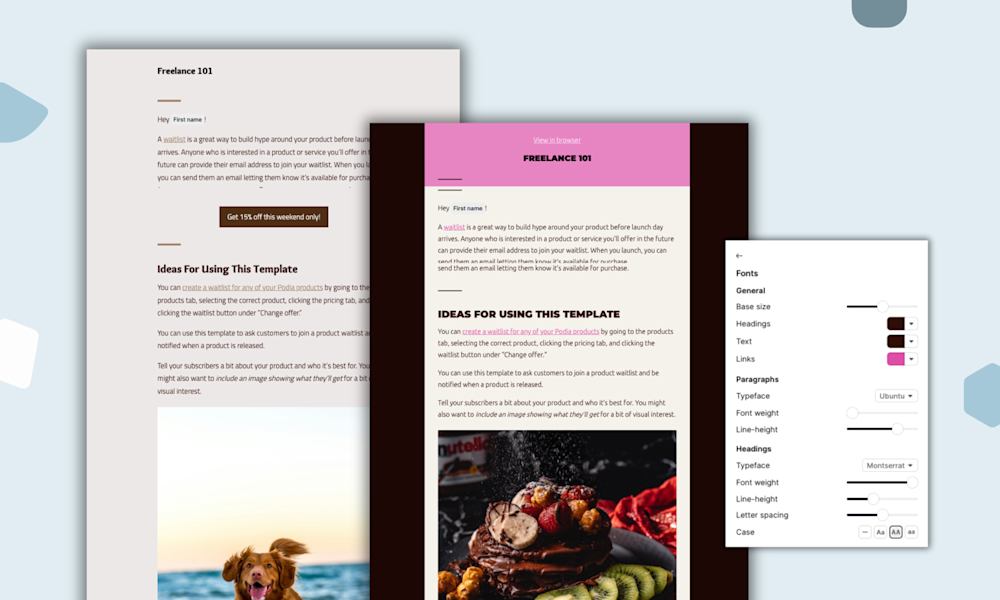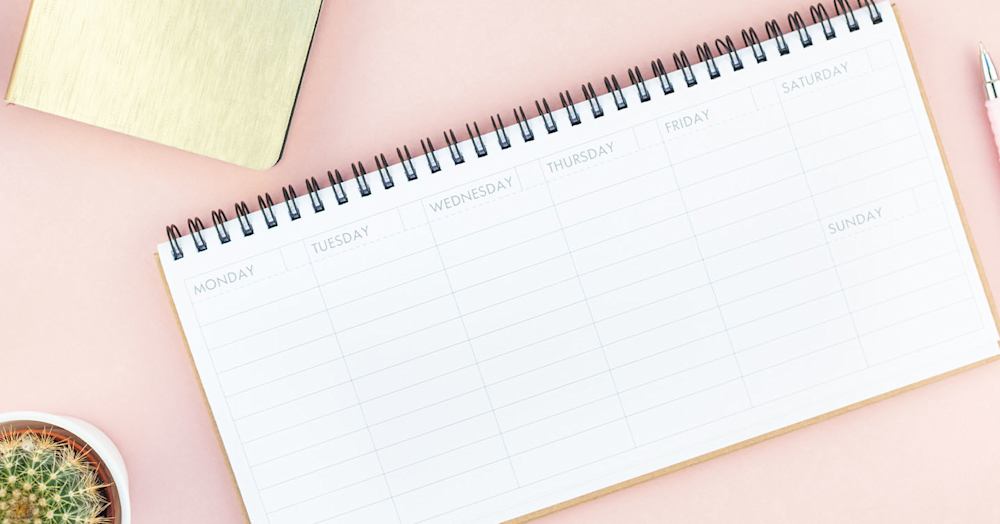You know you need to create a newsletter, but writing the copy feels a little daunting.
How will you get your readers’ attention and make them want to open your emails every time?
The good news is that you don’t need to be a writer to create copy that will wow your audience.
With our tips, you can become a wonderful newsletter creator without pretending to be somebody you’re not. Your skills and passions speak for themselves; all you need is a bit of focus.
Structure your email around a clear goal
To start a journey, you need a destination. It’s the same thing with every newsletter you create.
Ask yourself, “What’s the outcome for this email?” and work your way backward. For example, you could want them to click and read your latest blog or buy a product.
Once you know your outcome, work out how you can make that journey as easy as possible for your reader.
For example, Brooks wanted their subscribers to use their online shoe finder.
They started their email with an intriguing photo of mismatched shoes. The photo is accompanied by the graphic text “Let us pair you up”. The text below continues to warm up the reader towards the goal with a friendly conversational style.

They then switch colors with the next section to draw the eye to it. If the reader were just skimming the email, that’s where they’d likely land. This is where they introduce the call to action (CTA).

Placing your CTA further down in the body copy increases conversions by 304% compared to having it at the top. Even better is to have it stand out, as Brooks does, with a bold button.
Indeed, an easy-to-spot CTA generates 232% more clicks than one buried in the email. So if you want to know how to convert subscribers to customers, make your CTA visible.
Draw even more attention to your CTA by following Moment’s approach. To promote their series of photography tips, they created a dedicated newsletter.
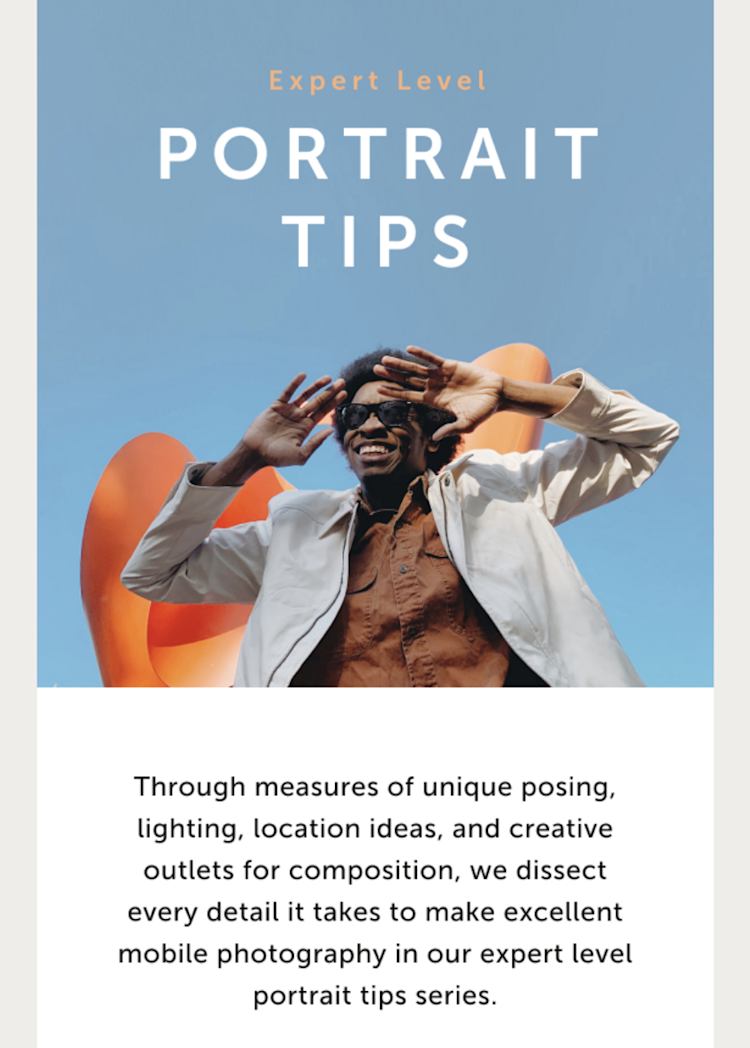
Each of the five tips is given its box, with some advice and two photos to illustrate the point. A button leads the reader to that specific tip, but you’re encouraged to stay in the email to see all five recommendations.
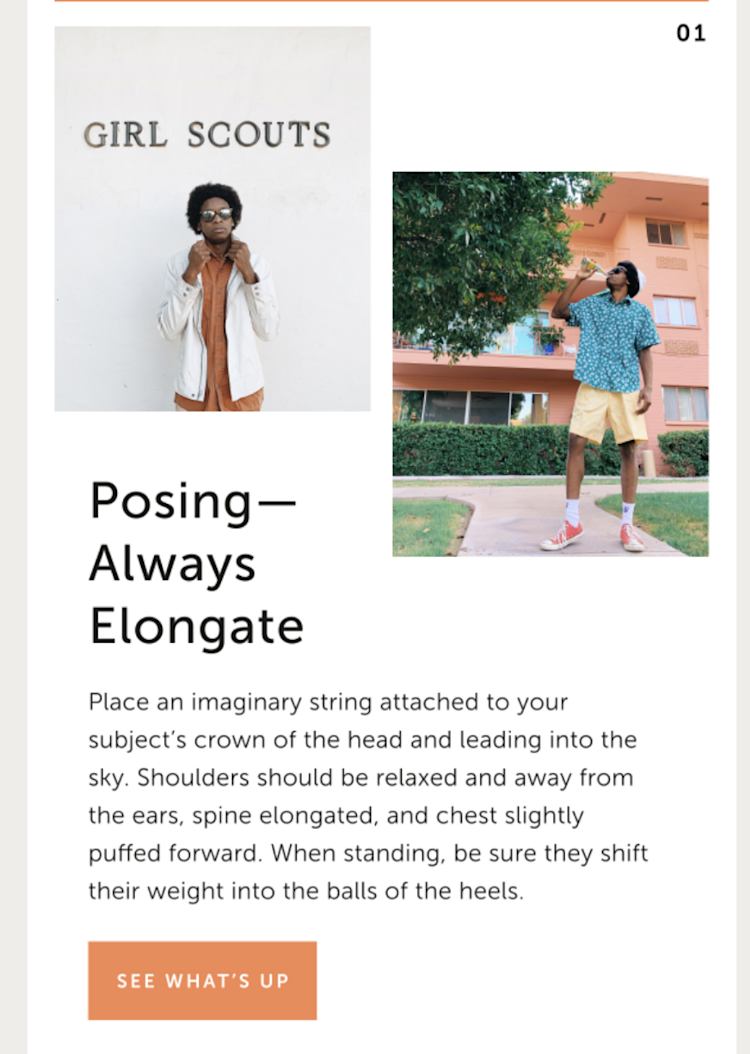
Then, you can click through to see the complete series of blog posts.
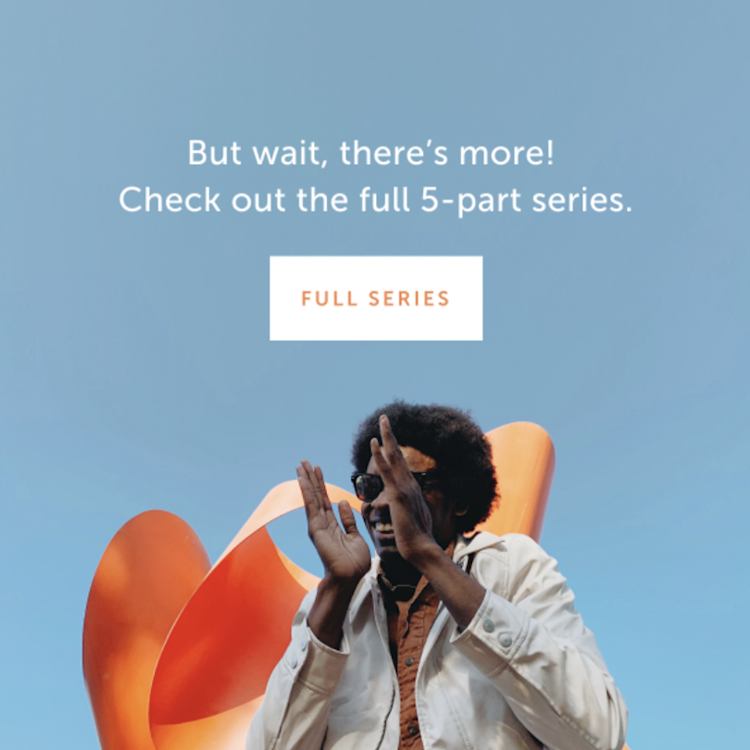
What works about this approach is that it guides you across the series of blogs, offering value in each summary. By the time you get to the CTA, you’re ready and excited to know more.
Like Moment, you can offer multiple opportunities for your readers to click. They also use the lower section of their newsletter to publicize other offers, such as this trip to Iceland.
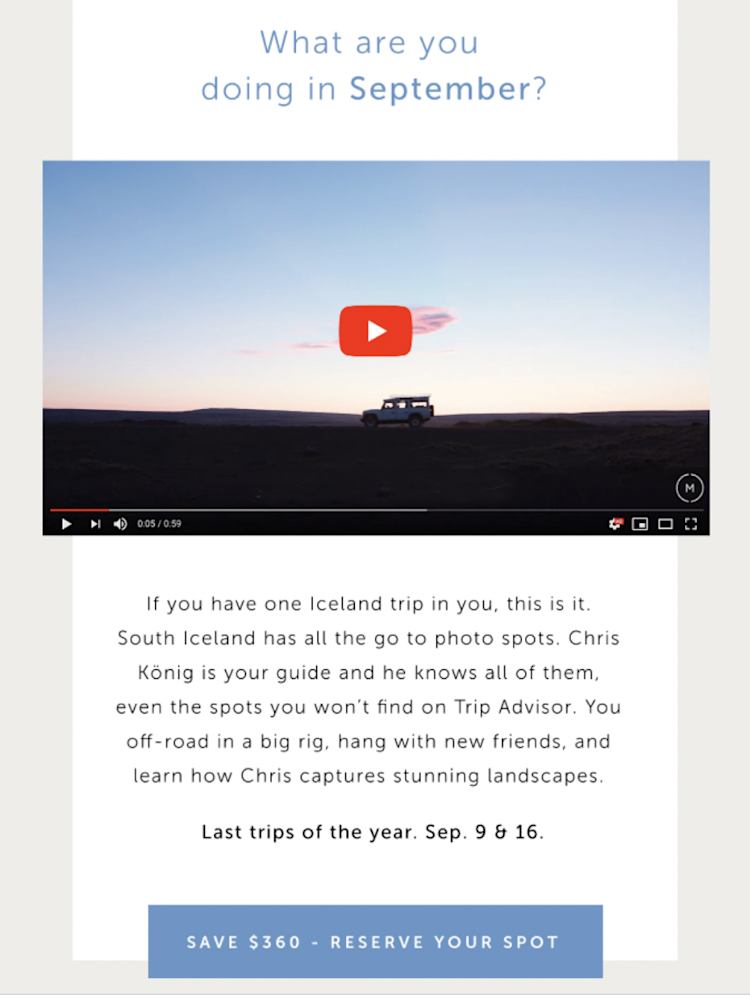
This works because the primary CTA and purpose of the newsletter are clear and established. It doesn’t distract. But this doesn’t mean you should try and stuff every single offer you have in each newsletter.
If you’re ready to plan your email journey, download our outline template. You can also edit it directly in Canva.
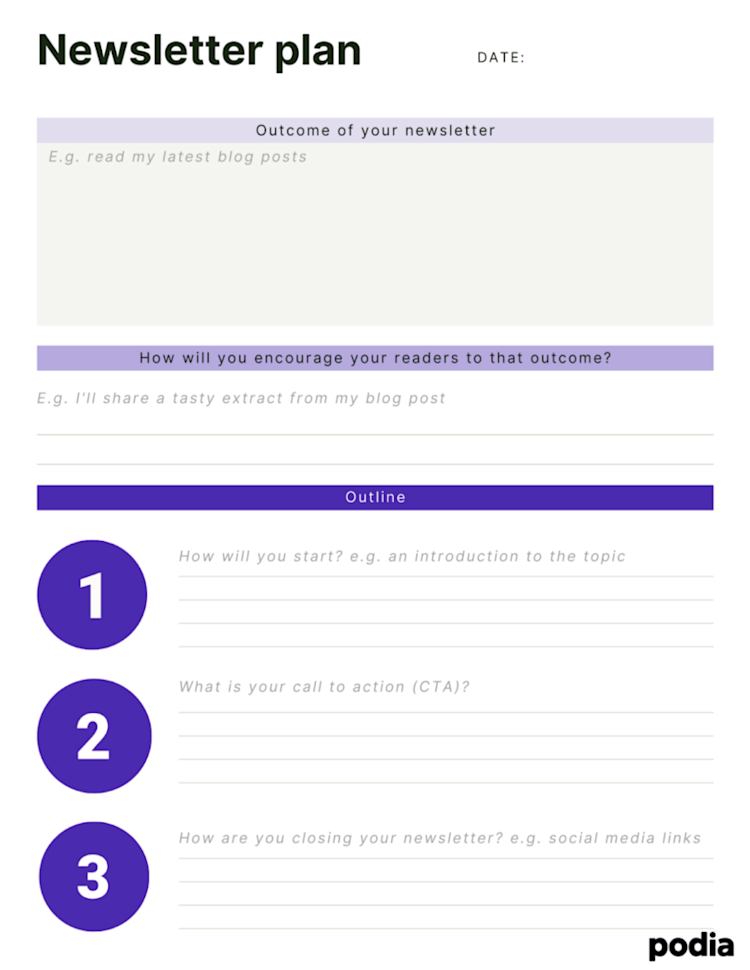
Once you’ve found an effective email structure and chosen your CTAs, the most challenging part is done. Now you just need the great email content to go with it.
You might think that strong writing is all about cleverness and flourishes, but it’s much better to be understood. And who understands you better than a friend?
Write to your reader as if they were a friend
If you’ve read any newsletter advice, then you’re bound to have stumbled across this gem: “personalize your emails”.
Personalizing your emails is a great idea, but not in the way you think. Forget about adding the reader’s first name — it can go wrong easily, and it doesn’t make your email personal.
What makes your email personal is your copy. Good email copy feels like it was written just to you by someone you know. It taps into your needs, desires, or sense of humor.
This is why the best newsletter writers, like Ann Handley, deliberately write their copy as if it were to a friend. This played a not insignificant part in her newsletter’s success (over 50,000 subscribers at the time of writing).
Here’s an extract from a recent newsletter by Ann that shows how friendly and personal her writing is.

Note the familiar opening “Hi, Sweet Cheeks” and how she quickly involves her reader with “You might know him as”.
Like Ann, you could work your way to your reader’s hearts by writing to them as if they were a friend.
Use second-person pronouns (“you/your”) and the active voice as much as possible.
For example:
Instead of “Our cake recipes are loved by our members,” say, “You love our cake recipes”.
Or instead of “Readers have been found to struggle with semicolons,” say, “I know you hate semicolons”.
The new versions are more direct and grab your reader’s attention. Use this approach to help your subscribers care about what you’re saying.
If you’d like to get some writing inspiration, here is a selection of free email templates:
-
Eight sales email templates to build your newsletter campaign
Segment your email list
In order to write your subscriber as if they were a friend, you have to know them a little.
This is where segmentation comes into play.
Segmentation is the process of separating your mailing list into different demographic groups. You can then send email marketing campaigns that are more relevant to each segment.
For example, you could have a segment for new subscribers and use it to send them emails that get them up to speed with what you do.
Segmenting is incredibly powerful. 82% of marketers report a higher open rate and with segmented campaigns compared to non-segmented campaigns.
Segmentation does come with a few warnings, though.
For example, you might think that segmenting your list by gender or age is a wise move. But it doesn’t tell you anything useful about a person’s interests or concerns.
Instead, it’s better to segment by pain points and past behavior than by demographics.
For example, if you sell painting courses, separating your audience by gender isn’t going to help sell your classes. Knowing what classes they’ve signed up for previously (watercolor for beginners, acrylic portraits, etc.) gives you much more helpful information.
If you haven’t segmented your audience at all when building your email list, don’t panic.
Here are two easy segmentation methods that you can implement at any stage of your email list. Segment your subscribers based on their past purchases or behavior.

Segmenting by purchasing behavior means segmenting based on what lead magnets or new products they’ve bought. This is particularly good if you have diverse offerings.
For example, imagine you offer a downloadable “social media 101 checklist” and an “advanced blogger automation” course. Based on their purchases, these audiences have different ability levels.
In that case, it’d make sense to send them different newsletters — for example, one would include more beginner-level resources.
Subscriber behavior is a segment based on your subscriber’s actions. You could send an email to subscribers who’ve abandoned items at checkout to re-engage them or to new subscribers to welcome them.
For example, Birdie sends this follow-up to new subscribers. She introduces herself and her work, so they feel welcomed into her space.
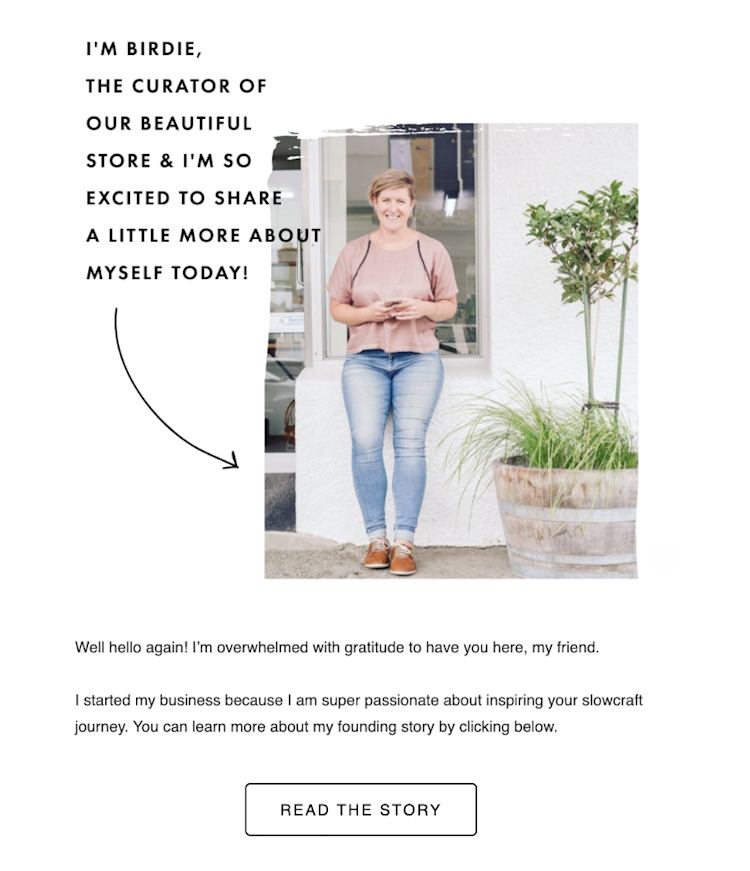
Like Birdie, you could share some personal information about yourself and your business. This will make your new email subscribers feel welcomed and engaged.
There’s a third marketing strategy, and that’s to ask your audience which segment they belong to. Here’s how Vassilena Valchanova does it.
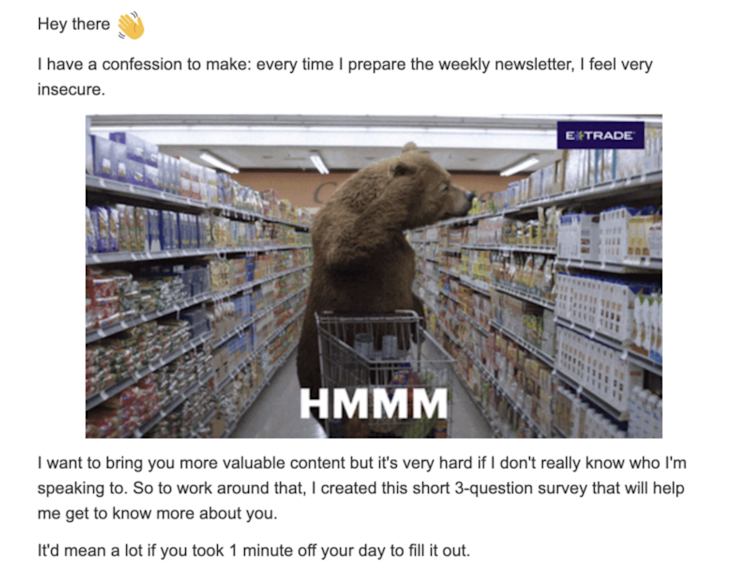
This email helps her segment her audience based on their roles (freelancers, in-house marketers, etc.) and their interests.

Once they’ve filled in the short survey, Vassilena ensures they only get the kind of content they want in their inbox. It’s a win-win for subscriber and newsletter creator alike.
Here’s the gist:
Get personal with your email copy and write to your reader as if you know them. Don’t be afraid to segment your list if it helps you be more precise with your email copy.
Grab your reader’s attention before they open your email
Writing better email copy is only part of the equation. To get your newsletter to the next level, you need to improve what surrounds it: your subject line, preview text, and your sender’s name.
These might feel secondary to your email, but they all play a significant part as to whether someone opens it or not. 47% of recipients open emails based on their subject lines alone. Meanwhile, 42% of people check the sender’s name before they open them.
One of the biggest email copywriting tips I can offer is don’t treat them as an afterthought.
Choose your sender’s name
Your sender’s name is your displayed name. For example, here are a few sender’s names in my inbox, coupled with their subject line.

There’s some variety there, from business names (Netflix, EFS, BrowserStack), personal names (Allison and Ashleigh), and an in-between option (Will at Mailjet). These represent the three most common approaches for sender’s names.
Which one is right for you and your small business?
There are a few tests your sender’s name needs to pass to avoid hitting the spam folder.
It needs to:
-
Look legitimate. Don’t use an email address as a display name.
-
Be recognizable by the reader. A person’s name is generally only suitable if that’s your brand or accompanied by the brand name (e.g., Will at Mailjet).
-
Stay consistent. Don’t switch it up every time you send an email.
-
Be short, or it might get cut off. For example, my Gmail inbox cuts names off after about 20 characters.
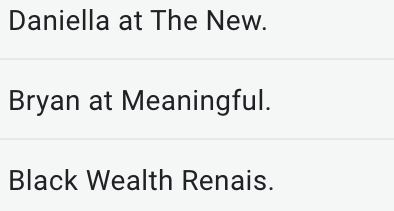
Small but mighty, your name is the first thing readers see in their inbox. Here’s the second.
Brainstorm your subject line
Email subject lines will always be the subject of passionate debate, and there are many formulas you can draw on to create an effective one.
Here are just a few you can inspire yourself from:
-
Ask a question, e.g., “Wouldn’t you love to work a three-day week?”
-
Create a sense of urgency, e.g., “Spring discount ends tonight at midnight”.
-
Share a “how to”, e.g., “How to trim your cat’s claws without losing an arm”.
-
Include a statistic or number, e.g., “57% of sailors love oranges more than bacon”.
-
Showcase a list, e.g., “17 ways to make a table without tools”.
-
Be clear about what’s inside, e.g., “[Podcast] Meet our founder”.
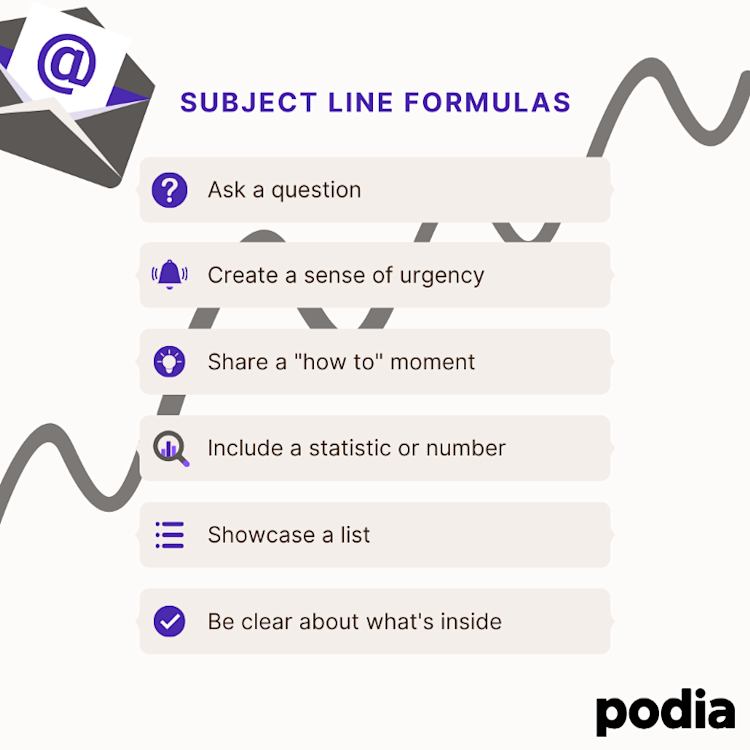
Hesitating about which one to pick? When in doubt, it’s always better to be clear rather than clever.
Your readers need to know at a glance what’s in it for them. Trust me. No one will complain that your subject line is too easy to understand.
You can also combine the formulas listed above. This subject line from Jimmy Daly’s Superpath newsletter is an excellent example of being transparent and using the “how to” approach. Before opening it, you already know what it is and how useful it’ll be to you.

The subject line is only half the story; it needs to work in tandem with your preview text to be powerful. The preview text, sometimes referred to as pre-header, is what appears next to your subject line in your inbox.
Take a look at this subject line and preview text from The Newsette. The subject line alone is intriguing, but the preview text is what pushes it over the edge with its humorous tone.

You want to click to see if ketchup masks are absurd or not. (Spoiler: they are).
You, too, can create intriguing subject lines like the Newsette’s. Just make sure your content follows through, or you could prompt a wave of unsubscribes.
Subject lines don’t need to be elaborate or witty to work. They just need to bear your audience in mind.
You’ve already worked out the outcome of your email and written your copy. Display names, preview texts, and subject lines are the final push to persuade your readers to open your email.
Nail your email copywriting strategy
You don’t need to be a professional writer or know anything about content marketing to create newsletters your audience will love.
Here are the steps to follow to create your next email:
-
First, start with your goal to build an outline for your email.
-
Next, decide what your reader’s journey will be. This includes choosing your primary call to action.
-
Personalize your email by talking to your reader directly and segmenting your list to reflect their interests.
-
Choose a sender’s name that’s recognizable, such as your company name.
-
Design a powerful subject line and preview text to encourage your readers to open your newsletter.
If you follow these steps, you’ll build an email newsletter that is true to you, and which your subscribers can’t wait to read.
